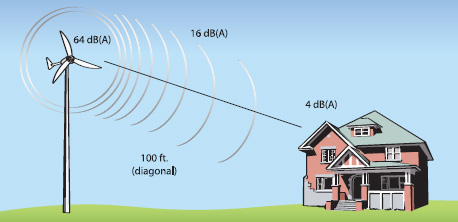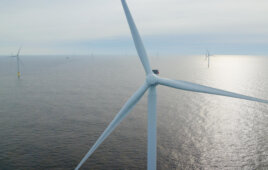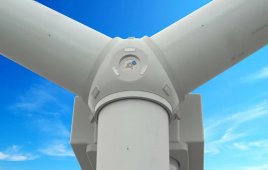Modern small wind turbines have better insulation, lower rotation speeds, fewer moving parts, no gearboxes, and more efficient blades that make them much quieter than their ancestors. Today’s small wind turbines emit sound that is barely discernible from ambient noise, even with a decibel (dB) meter. Sound from traffic, rustling trees, airplanes, and people in fact often sufficiently mask the dull, low, “white noise” sounds a small turbine can make at certain wind speeds. Only during short-term events like severe storms or utility outages do small wind turbines make distinctive sounds, but in these occurrences ambient sound levels increase as well.
To put this into further perspective, the sound made by the lanyard clasp on a flagpole line hitting its pole is far more “tonal” and distinguishable than any sound a small wind turbine makes, and is less easily masked by ambient sounds.
Zoning policy should reflect ambient sound levels as well as occasions where no affected parties are located immediately outside a property boundary. Therefore, except during short-term events like storms and utility outages, a small wind system should be installed and operated such that sound pressure levels do not exceed the definition of “nuisance noise” as established by existing zoning code. or at the nearest dwelling, whichever is greater. Sound levels should always be measured downwind of the turbine to account for the canceling effect of the sound of the wind itself. If ambient sound levels exceed “nuisance” levels on certain occasions, such as during storms, sound level limits of small wind systems should also be given reprieve during these events which are out of everyone’s control.

Sound waves are diluted with distance
Or, instead of singling out wind turbines in sound regulations, it may be more fair and administratively simple to use default sound/noise regulations that apply universally to other objects and appliances in a community. The small wind section of Wisconsin’s (state-wide) zoning ordinance, for example, has no mention of sound because its designers chose to treat small wind turbines equally with other allowed devices/structures.
Also Keep in Mind
- Sound decreases significantly with distance from the source (including height – another good reason to allow tall towers). Doubling the distance from the turbine decreases the sound level by a factor of four. For example, sound level readings at 25ft. from the turbine hub drop by a factor of 4 at 50ft., and by a factor of 16 at 100ft. Noise intrusion across a property line from a turbine that is set back 100ft. or more is typically very limited.
- Turbine manufacturers are keenly aware of the public demand for quieter machines and have invested in new materials and designs to minimize sound. As a result, today’s turbines operate at near-ambient sound levels.
- Only a few events or circumstances can cause a normal operating wind system to become audible, including utility blackouts (or a full battery bank for those models that incorporate batteries). Both situations are temporary, and in many cases (but not all), easily remedied by the owner by manually shutting down the turbine.
- Sound level test data for some turbines is available from the U.S. Department of Energy’s (DOE) National Renewable Energy Laboratory (NREL).7
- Requiring certified noise tests for a residential wind system is unnecessary given the lower sound emissions of today’s turbines and that sound data is readily available from manufacturers. Such tests are also beyond the budget of any homeowner.
- “Noise” is a subjective term. Whether a person generally favors wind turbines or not can determine how he or she views a single, seemingly objective sound.
- The single best way to understand the nature of a turbine’s sound is to visit an installation site. All turbines are a marginally different so be sure to visit a location with a similar wind resource and the same model turbine as is in question.
Filed Under: Construction, Projects





Constant low level sound has been shown to have unhealthy psychological effects on human beings including depression and exhaustion
“Requiring certified noise tests for a residential wind system is unnecessary” – sounds like something a salesman would say! I would definitely want to see the results of independent noise level measurements before I bought a small scale wind device.